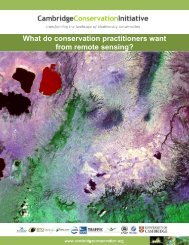CONSERVING BIODIVERSITY & DELIVERING ECOSYSTEM SERVICES
conserving biodiversity & delivering ecosystem services
conserving biodiversity & delivering ecosystem services
You also want an ePaper? Increase the reach of your titles
YUMPU automatically turns print PDFs into web optimized ePapers that Google loves.
The most threatened IBAs in Nepal<br />
■<br />
■<br />
■<br />
■<br />
■<br />
Dharan forests: PROTECTION STATUS: unprotected.<br />
CONSERVATION STATUS: high pressure, very<br />
unfavourable state, negligible response. Sal forest<br />
is being lost due to encroachment for settlements and<br />
cultivation and the development of a road.<br />
Dhorpatan hunting reserve: PROTECTION STATUS:<br />
protected. CONSERVATION STATUS: high pressure, very<br />
unfavourable state, low response. There are many<br />
pressures on this reserve, including illegal collection<br />
of firewood and timber, and crop farming due to<br />
favourable climatic conditions.<br />
Mai Valley forests: PROTECTION STATUS: unprotected.<br />
CONSERVATION STATUS: high pressure, very unfavourable<br />
state, negligible response. The site is a Community<br />
Forest, and whilst the approved forest management<br />
plan is leading to some positive changes (e.g. removal<br />
of Japanese Sallo and replacement with native<br />
broadleaved forest), in many parts of the IBA illegal<br />
farming on hill slopes is taking place. Increased<br />
farming of cash crops like cardamom and tea is also<br />
changing the habitat into a monoculture.<br />
Farmlands of Lumbini: PROTECTION STATUS:<br />
unprotected. CONSERVATION STATUS: high pressure,<br />
unfavourable state, medium response. The major<br />
threats at this site are rapid urbanisation, the impact<br />
of increasing numbers of tourists and, most<br />
important, changes in agriculture such as cash crop<br />
production and increasing use of chemicals.<br />
Tamur Valley and watershed: PROTECTION STATUS:<br />
unprotected. CONSERVATION STATUS: high pressure, very<br />
unfavourable state, negligible response. Loss and<br />
degradation of broadleaf and rhododendron forest is<br />
expected as a result of expanding settlements,<br />
infrastructure development, particularly roads, and<br />
unregulated and unsustainable harvesting practices.<br />
Logging is a threat to many IBAs in Nepal(David Thomas)<br />
Overall, it is anticipated that by 2020 there will be a trend<br />
towards reduced forest cover and increased agricultural land<br />
across the network of IBAs. It is also predicted that the area of<br />
shrubland will increase as forests become degraded and that<br />
introduced plants will become more widespread. The projected<br />
decrease in snow, ice and grasslands across high altitude IBAs is<br />
a reflection of the likely impact of climate change on montane<br />
ecosystems across the country (see figure).<br />
How habitats within IBAs might change by 2020 as a result of<br />
current drivers of change<br />
SOURCE Based on information provided at an expert consultation workshop.<br />
An example from Rara National Park IBA<br />
Rara National Park is the smallest Protected Area in Nepal containing the country’s largest and most enigmatic lake. It has<br />
forest, grassland and wetland habitats and is important for Cheer Pheasant and Himalayan Monal, and other wildlife<br />
including Red Panda and Clouded Leopard. Historically, low intensity use of the meadows and forests by local<br />
communities has contributed to protecting the environment in this region. However, pressures on the relatively intact<br />
habitats inside the core zone are increasing due to over-harvesting and changes in land use in the surrounding buffer zone.<br />
“In the buffer zone, the impacts of illegal timber extraction can be seen close to the towns where timber is in<br />
high demand” says Bhogendra Rayamajhi, Assistant Warden. “There is a risk that, by 2020, forests in the<br />
buffer zone will be much reduced and communities will encroach more and more into the core area for their<br />
livelihood needs, threatening the biodiversity and also the future of the important services this site delivers”.<br />
For more details of this study, see p.30.




